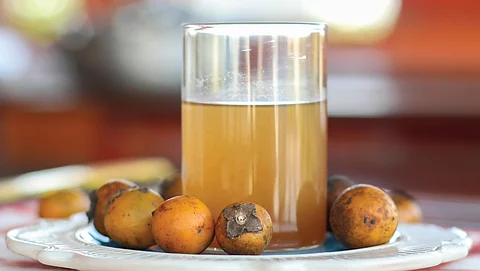

Green gold. That is what the tendu tree or East Indian ebony is usually referred to because of its economic importance as a non-timber forest produce (NTFP). During the lean summer months, when agricultural or other income-generating activities are limited, the tree, found abundantly in the deciduous forests of central India, provides an assured seasonal income to hundreds of thousands of tribal communities. Its large, pliable leaves are in demand for making beedis (indigenous leaf-rolled cigarettes). Though the tendu tree can grow up to 25 metres tall, forest-dependent communities usually prune the trees for easy harvesting of leaves. But from the unpruned branches, small fruits of golden hue begin to drop as the summer progresses.
For the forest-dependent communities, these fruits are a prized catch. The fibrous pulp, which is sweet in taste with a hint of astringent and earthy flavour, remains encased in a thin shell. But unlike most other fruits, tendu fruit takes almost a year to ripen. Though a mature tree can yield 80-100 kg of tendu fruit in a year, the actual harvest collected from the forest floor is much lesser as the fruit spoils quickly. However, the silver lining is that the fruits fetch a good price in local markets. In Bundelkhand region, for instance, 250 g of tendu fruits is sold for Rs 30. Since the fruit has a short shelf life of around five days, some tribal households dry and powder the extra harvest and save it for the rainy season, when it is used to prepare a soup.
Scientific research shows that the fruit comes loaded with essential nutrients. Because of its astringent or cooling properties, consumption of tendu fruit, either raw or in the form of a sharbat, is considered beneficial during the hot summer months (see recipe). Researchers from the Amity Institute of Food Technology, Amity University, Noida report in the journal Plant Archives in 2021 that the fruit pulp is rich in calcium, magnesium, sodium, potassium, phosphorous, thiamine, riboflavin, niacin and vitamin C, with potassium being as high as 305.52 mg per 100 g. It suggests that the pulp could be an excellent source of healthy phytochemicals.
The fresh fruit is also rich in total phenolic content, flavonoids, antioxidants and ß-carotene content, which reduce oxidative stress in the body and have free radical-scavenging ability. In fact, these dietary components are present in tendu in equal or higher proportions than in guava, plum, star fruit, mango, kiwi and even apple, suggests a review paper published in Horticulturae in 2022. This is probably the reason for tendu being scientifically named Diospyros melanoxylon—Diospyros comes from Greek words dios, which means divine, and pyros or fruit, suggesting that fruits of this genus are revered for the benefits they offer.
For those not familiar with tendu fruit, it tastes somewhat like chikoo or sapote (Manilkara zapota) and has seeds that resemble the latter. But the two are not related. Instead, tendu belongs to the genus of 700 species which are either valued for their fruit or wood. One such species is the large, orange-coloured winter persimmon (Diospyros virginiana), also known as ramphal or Japani phal, which is native to North America but has a growing market in cities like Delhi.
In recent years, there have been efforts to prepare value-added products using the fruit pulp of tendu. Researchers from Indira Gandhi Krishi Vishwavidyalaya in Raipur, Chhattisgarh have developed ways to prepare juice, jam and ice cream using the pulp. However, there is an urgent need to promote the tree beyond the wilderness, given the fact that almost every part of tendu tree has economic importance.
The revenue-generating potential of tendu leaf is evident from the fact that it is a nationalised NTFP, meaning its collection and trade are regulated by the state governments. In 2024, the Chhattisgarh government alone earned Rs 942.12 crore from the sale of tendu leaves, as per the State Minor Forest Produce (Trading and Development) Cooperative Federation Limited. With 7.12 per cent protein and 25.28 per cent fibre, fresh leaves of tendu also make nutritious fodder.
The seeds too have medicinal properties, which in Ayurveda are known to cure mental illnesses such as nervous breakdown and palpitations of the heart. Dried flowers are reportedly useful in urinary and skin infections and blood diseases such as anaemia. Decoction of the bark, which has an astringent taste, is used to treat diarrhoea. Furthermore, the tree’s whitish-pink wood is valued for its strength and durability, and is used as poles, mine props, in the construction of buildings and as shafts of carriages.
Since the tree is native to India, drought-tolerant and can survive in poor denuded soils, hot and dry hill slopes, rocky soils and heavy clays, it is well-suited to be grown in large parts of the country. In fact, the tree has a deep taproot that helps it survive in arid regions. All this versatile tree requires is policy support.
Ingredients
Tendu fruits: 250g
Sugar: to taste
Salt: to taste
Method
Break the fruits and remove its hard coat or outer covering. Add water to the pulp and mash well. Pass the pulp through a sieve to remove seeds and pieces of the fruit coat. To the diluted pulp add sugar and salt. Add ice cubes to the juice; the healthy sharbat is ready to drink.
Ingredients
Tendu fruit: 250g
Milk: 1 litre
Cardamom: 2
Sugar to taste
Method
Prepare thickened milk by boiling it. Add sugar and crushed cardamom. Remove the fruit coat and seeds; add the pulp to milk. Boil for some more time till it attains uniform consistency. The kheer is ready.
This article was originally published in the May 1-15, 2025 print edition of Down To Earth